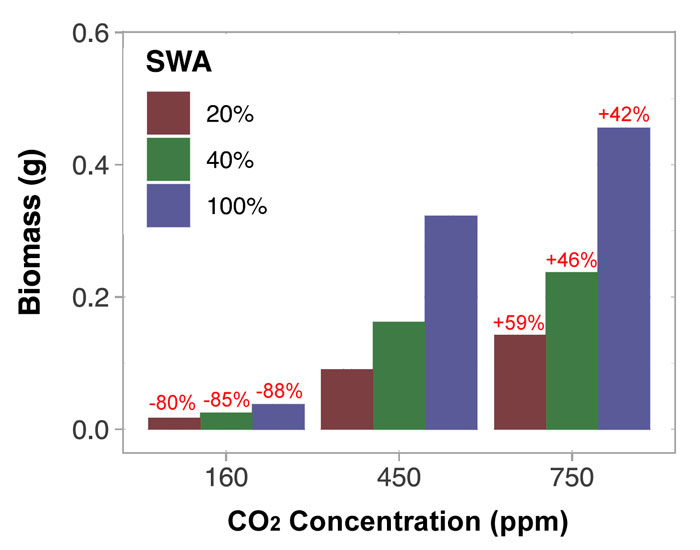| Tweet | Follow @co2science |
Paper Reviewed
Temme, A.A., Liu, J.C., Cornwell, W.K., Aerts, R. and Cornelissen, J.H.C. 2019. Hungry and thirsty: Effects of CO2 and limited water availability on plant performance. Flora 254: 188-193.
Do you ever wonder what the impact would be if policy makers regulated CO2 emissions so as to actually reduce the CO2 concentration of the atmosphere?
Such action is the stated goal of all candidates seeking the Democrat Party's nomination for President of the United States, as well as many others. Well, thanks to the recent study of Temme et al. (2019) we can at least catch a glimpse of one of the likely impacts of this policy goal, and it is not pretty.
The not-so-favorable outcome is presented in the figure below. There, Temme et al. have pooled the growth response, or biomass, of seven C3 annual plants in response to three different soil water availability (SWA) treatments and three atmospheric CO2 concentrations: 160 ppm (characteristic of historic values at the last glacial maximum), 450 ppm (similar to today's concentration of approximately 412 ppm) and 750 ppm (estimated potential future value by the year 2100). As expected, because atmospheric CO2 is food for plants, incredible growth increases are witnessed in these annuals as the CO2 concentration rises, regardless of SWA treatment; relative to the growth experienced at 160 ppm, plant biomass increased between 400% and 700% at present-day CO2 concentrations, and by a whopping 700 to 1,000% at future-predicted CO2 concentrations! Viewed from a different perspective, when analyzing these results relative to today's CO2 concentration, future increases in CO2 will stimulate the biomass of these annuals between 40% and 60%, whereas a return to historic concentrations of the last glacial maximum will cause biomass reductions on the order of 80% to 90%.
Given the above, it is highly unlikely that human society or nature could survive a return to glacial maximum CO2 concentrations without massive repercussions, including the widespread destruction and possible extinction of numerous species. And although no one in their right mind is presently advocating for a return to those conditions, clearly, the relationship in this graph reveals that any reduction in the CO2 content of the air (relative to today) would reduce plant biomass and negatively impact humanity and the natural world. Yet this is exactly the misguided course of action that many are pursuing. It is high time they wake up and recognize that CO2 is not a pollutant, but a miracle molecule providing numerous biospheric benefits, while only minimally impacting climate.

Figure 1. Pooled plant biomass response of seven C3 annuals to three different soil water availability (SWA) treatments at three atmospheric CO2 concentrations. The percentages shown in red above the 160 and 750 ppm CO2 columns indicate the percent change in biomass relative to corresponding SWA treatments at ambient CO2 (450 ppm). Source: Temme et al. (2019).




